Plus Two Chemistry Chapter Wise Previous Questions Chapter 9 Coordination Compounds is part of Kerala Plus Two Chemistry Chapter Wise Previous Year Questions and Answers. Here we have given Plus Two Chemistry Chapter Wise Questions and Answers Chapter 9 Coordination Compounds.
Kerala Plus Two Chemistry Chapter Wise Previous Questions Chapter 9 Coordination Compounds
Question 1.
[Cr(NH3)4CI2] Br is a co-ordination compound. (March – 2010)
a) Identify the central metal ion of the above compound.
b) Name the ligands present in it.
c) What is its coordination number?
d) Write its IUPAC name.
e) Write the Ionization isomer of the above compound.
Answer:
a) Chromium (Cr)
b) Ammine (NH3), Chloride (CI – )
c) 6
d) Tetraamminedichloridochromium (lll)bromide
e) [Cr(NH3)4CIBr] CI. By exchanging the ions inside and outside the coordination sphere.
Question 2.
When CuSO4 is mixed with an excess of NH3, a deep blue coloured solution is obtained. (Say – 2010)
a) Write the formula of the compound formed.
b) What is the IUPAC name of the compound?
c) What do you understand by the term coordination number and ligand in a coordination compound?
d) Give the oxidation number and coordination number of the central metal atom of the deep blue coloured compound.
Answer:
a) [Cu (NH3)4]SO4
b) Tetraammine copper (ll) sulphate
c) It is the number of ligand atoms to which the metal is directly bonded. Ligands are neutral molecules or ions bounded to the central atom/ion in the coordination entity.
d) Oxidation number of Cu in [Cu(NH3)4]SO4 is +2 Coordination number of Cu in [Cu(NH3)4]SO4 is 4.
Question 3.
The geometry and magnetic properties of complexes can be explained by V.B. Theory. (March – 2011)
The octahedral complex [Co(NH3]6]3+ is diamagnetic while the octahedral complex [C0F6]3- is diamagnetic. Explain using VB. Theory,
Answer:
In the complex, [Co(NH3)6]3+ the cobalt ion is in +3 oxidation state and has the electronic configuration 3a6. It undergoes d2sp3 hybridisation as shown below:
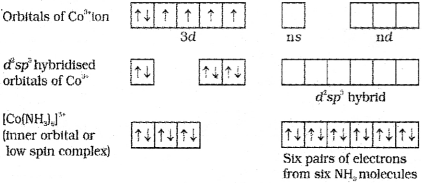
Here, the six pairs of electrons, one from each NH3 molecule, occupy the six hybrid orbitals. Thus, the complex has octahedral geometry and is diamagnetic be cause of the absence of an unpaired electron.
In [CoF6]3- also he cobalt ion is in +3 oxidation state and has the electronic configuration 3d6. Since F ion provides a weak ligand field one 4s, three 4p and two 4d orbitaIs hybridise to yield six sp3d2 hybrid or bitaIs pointing towards the six ends of an octahedron. The six Fions then donate a pair of electrons to each of these vacant orbitals to have an octahedral geometry. The presence of unpaired electrons in 3d orbit ais makes the complex paramagnetic.
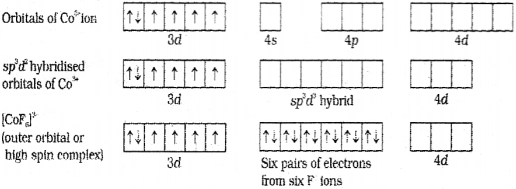
Question 4.
The central ion Ag+ with coordination number 2 forms a positive complexion with NH3 ligand. Also Ag forms a negative complex with CN- ligand.
a) Writetheformula of above positive and negative complexions. Give the IUPAC name of each.
b) Give the denticity of NH3 and CN- ligands.
c) Write the formula and name of a hexadentate ligand.
Answer:
a) [Ag(NH3)2]+ – Diamminesilver (l) ion [Ag(CN)2] – Dicya noargentate(l) ion
b) Denhcìty of NH3 is 1, since N isthe only donor atom. Densicity of CN is 2, since both C and N atoms can act as donor atoms.
c) (EDTA4) ion – Ethylenediaminetetraacetate ion.
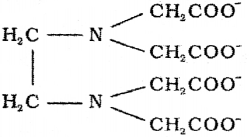
Question 5.
Consider the coordination compound [Co(NH3)5SO4] Br. (March – 2012)
a) Write the IUPAC name of the above coordination compound.
b) What is the primary valence and secondary valence of the central metal, cobalt, in the above coordination compound?
c) Which type of structural isomerism is exhibited by the above coordination compound?
Answer:
a) Pentaamminesulphatocobalt (lll) bromide
b) (Co (NH3)5 SO4] Br Primary valency = I Secondary valency =6
c) Ionisation isomerism.
Question 6.
[Cr(NH3)5CO3] Cl is a coordination compound. (Say – 2012)
i) Name the central metal ion of the above compound.
ii) What is its IUPAC name?
iii) Name the ligands present in the above compound.
iv) Whether the ligands present in the above compound are ambdentate ligands? Why?
Write the ionisation isomer of the above compound.
Answer:
i) Chromium (Cr)
ii) Pentamminecarbonatoch romium(lll) chloride
iii) Ammonia, Carbonate ion
iv) No. Both ammonia and carbonate ion are not ambidentate ligands because they have only one donor site to bind with the metal.
v) [Cr(NH3)5Cl] CO3 Pentamminechloridochromium (lll) carbonate
Question 7.
The magnetic behaviour of a complex can be explained on the basis of the Valence Bond (VB) theory. (March – 2013)
a) [CO(NH3)6]3+ is a diamagnetic complex and [COF6]3- is a paramagnetic complex. Substantiate the above statement using VB theory.
b) Classify the above-mentioned complexes into inner orbital and outer orbital complexes.
Answer:
a) Refer (March 2011 Question No.1
b) Inner orbital complex → [Co (NH3)6]3+ since the innerd orbital (3d) is used for hybridisation in this complex.
Outer orbital complex → [CoF6]3- since, the outer d orbital (4d) is used for hybridisation in this complex.
Question 8.
Many theories have been put forth to explain the nature of bonding in coordination compounds. (Say – 2013)
a) On the basis of valence bond theory account for the diamagnetic behaviour of [Ni(CN)4]2-.
b) What is the shape of the above complex?
c) Arrange the following ligands in the increasing order of their field strengths, (as per the spectrochemical series) CI-, CO, H20, OH
Answer:
a) In the complex ion [Ni(CN)4]2- the central metal atom Ni is in +2 oxidation state and has the electronic configuration 3d8. Since CN – is a strong field ligand two unpaired electrons are forced to pair up against and give fourdsp2 hybrid orbitals. Each of the hybrid orbitals receive a pair of electrons from a cyanide ion to form [Ni(CN)4]2. Since there is no unpaired electron, the complexion is diamagnetic.
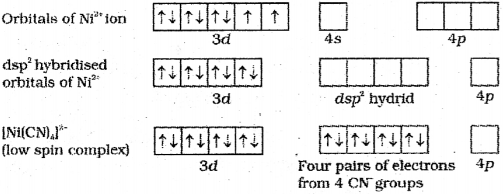
b) Since the hybridisation involved is dsp2 this complex has a square planar geometry.

c) Cl < OH < H2O < CO
Question 9.
[CO(NH3)5SO2]CI is an octahedral coordination compound. (March – 2014)
a) Write the IUPAC name of the above coordination compound.
b) Write the formula of the ionisation isomer of the above compound.
c) How do ‘d’ orbitals split in an octahedral crystal field?
d) Draw the diagram which indicates the splitting of ‘d’ orbitals in the tetrahedral field.
Answer:
a) Pentaamminesulphatocobalt(lli) chloride
b) [CO(NH3)5CI]SO4
c) In an octahedral crystal field the ligands approach the central metal atom/ion along the coordinate axes. Thus, the dx2 – y2 and dz2 orbitais which point towards the axes along the direction of the ligand will experience more repulsion and will be raised in energy; and the dxy, dyz and dxz orbitais which are directed between the axes will be lowered in energy relative to the average energy in the spherical crystal filed. The crystal filed splitting in an octahedral crystal field yield three orbitaIs of lower energy (t2g set) and two orbita Is of higher energy (eg set). The energy separation is denoted by Δ0. The energy of the two eg orbitais will increase by (3/5)Δ0, and that of the three t2g will decrease by (2/5)Δ0. The d-orbitai splitting in an octahedral crystal field is shown below:
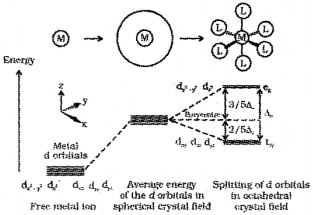
d)
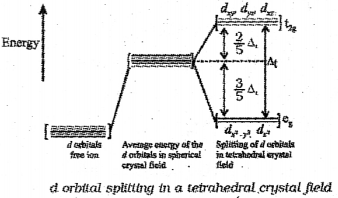
Question 10.
a) Valence Bond Theory (VBT) can explain the magnetic behaviour and shape of complexes. Using VBT explain the diamagnetism and square planar shape of [NKCN)4]2- (Say – 2014)
b) i) Suggest the shape of the following complexes Ni(CO)4 and [CoF6]3-.
ii) The central ion Co3+ with coordination number 6 is bonded to the ligands NH3 and Br to form a dipositive complexion. Write the formula or IUPAC name of the complexion.
Answer:
a) In the complex ion [Ni(CN)4]2 the central metal atom Ni is in +2 oxidation state and has the electronic configuration 3d8. Since CN – is a strong field ligand two unpaired electrons are forced to pair up against Hund’s rule and makes available a vacant 3d, one 4s and two 4p orbitals, which hybridise to give four dsp2 hybrid orbitals. Each of the hybrid orbitals receives a pair of electrons from a cyanide ion to form [Ni(CN)4]2-. Since there is no unpaired electron, the complexion is diamagnetic.

Since the hybridisation involved is dsp2 this complex has a square planar geometry.

b) i) In [Ni(CO)4] the central atom Ni undergoes sp3 hybridisation. Hence, it has a tetrahedral geometry. In [CoF6]3 the central metal ion Co3+ is in the sp3d2 hybridised state. Hence, it has an octahedral geometry,
ii) [Co(NH3)5Br]2+
OR
Pentaamminebromidocobalt(lll) ion
Question 11.
Coordination compounds contains central metal atom/ion and ligands.
a) Primary valency of central metal atom/ion in [Co(NH3)6] Cl3 is
i) 3
ii) 6
iii) 4
iv) 9
b) i) What are the postulates of Werner’s theory?
ii) Write the IUPAC names of K3[Fe(CN)6], [Co(NH3)6] Cl3.
a) i) 3
b) i)
1) In coordination compounds metals show two types of linkages (valencies) – primary and secondary.
2) The primary valences are normally ionisable and are satisfied by negative ions. ie. oxidation state.
3) The secondary valences are non – ionisable. These are satisfied by neutral molecules or negative ions. The secondary valence is equal to the coordination number and is fixed for a metal.
4) The ions/groups bound by the secondary linkages to the metal have characteristic spatial arrangements corresponding to different coordination numbers.
ii) K3[Fe(CN)6] – Potassium hexacyanoferrate(lll) [CO(NH3)6]CI3 – Hexaamminecobalt(lll) chloride
Question 12.
a) Write the IUPAC name of the complex K3[Cr(C2O4)3]. (Say – 2015)
b) Draw the figure to show the splitting of ‘d’ orbitals in octahedral crystal field.
c) [Fe(H2O)6]3- is strongly paramagnetic, whereas [Fe(CN6)]3- is weakly paramagnetic. Write the reason.
Answer:
a) Potassium trioxalatochromate(lll)

c) H2O is a weaker ligand compared to CN. There is no pairing of electrons in the d-orbital of Fe in [Fe(H2O)6]3+. But there is the pairing of electrons in the d-orbital of Fe in [Fe(CN6)]3-.
Question. 13.
a) Write down the ionization isomer of [Co(NH3), Cl] SO4. (March – 2016)
b) Write the IUPAC name of the above compound.
c) [Ni(CO)4] is diamagnetic while [Nid4]2 is paramagnetic though both are tetrahedral. Why?
Answer:
a) [Co(NH3)5SO4]Cl
b) Pentaamminechlondocobalt(lll) sulphate
c) In [NICI4]2- nickel is in +2 oxidation state and the Ni2 ion has the electronic configuration 3d6. It undergoes sp3 hybridisation.

Each CI ion donates a pair of electrons. The compound ¡s paramagnetic since it contains two unpaired electrons.
[Ni(CO4)] has tetrahedral geometry but is diamagnetic since nickel is in zero oxidation state and contains no unpaired electron.

Question 14.
Consider the co-ordination compound [CoNH3)5Cl]Cl2 (Say – 2016)
a) Write the IUPAC name of the above coordination compound.
b) i) What is the primary valency and secondary valency of the central metal ion in the above co-ordination compound?
ii) Write the name of isomerism exhibited by the complex [Pt(NH3)2Cl2] Represent the possible isomers.
Answer:
a) Pentaamminechloiidocobalt(lll) chloride
b) i) Primary valency: +3 Secondary valency: 6
ii) Geometric isomerism or cis-trans isomerism

Question 15.
(Co(NH3)5SO4]CI and [Co(NH)5Cl]SO4 are coordination compounds. (March – 2017)
a) Identify the isomerism shown by the above compounds.
b) Write the IUPAC names of the above compounds.
c) Identify the ligands ¡ri each of the above compounds.
Answer:
a) Ionisation isomerism
b) [Co(NH3)5SO4]CI – Pentaamm in sulphate cobalt(III) chloride
[Co(NH3)5Cl]SO4 – Pentaamminechloridocobalt(III) sulphate
c) In [Co(NH3)5SO4]CI the ligands are NH3 and SO4.
In [Co(NH3)5Cl]SO4 the ligands are NH3 and Cl.
Question 16.
a) In which of the following, the central atom/ion is in zero oxidation state. (Say – 2017)
i) [Ni(CN)4]2-
ii) [NiCl4]2-
iii) [Ni(CO)4]
iv) [Ni(NH3)5]2+
b) [Ni(CN)4]2- has square planar structure and it is diamagnetic.
i) On the basis of valence bond theory explain why [Ni(CN)4)2- exhibit these properties.
ii) Identify the ligand in the above-mentioned complex.
Answer:
a) iii) or [NiCo)4]
b) i) dsp2 hybridisation or No unpaired electrons or CN is a strong field ligand.
ii) CN- or cyanide ion
We hope the Kerala Plus Two Chemistry Chapter Wise Questions and Answers Chapter 9 Coordination Compounds help you. If you have any query regarding Kerala Plus Two Chemistry Chapter Wise Questions and Answers Chapter 9 Coordination Compounds, drop a comment below and we will get back to you at the earliest.
